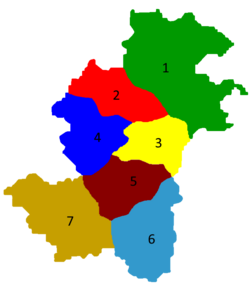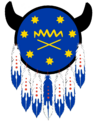The Meoquanee
The Meoquanee
ᎠᏥᏏ ᏍᎦᏯᏓ Great Meoquanee Nation | |
|---|---|
Tribal Confederation | |
|
| |
 | |
| Confederated | TBA |
| Government | |
| • Type | Tribal Council |
| • Council | Council of Seven Fires |
| Population (2018) | |
| • Total | 505,021 |
| Demonym | Meoquanee |
| Time zone | UTC−06:00 (CST) |
| • Summer (DST) | UTC−05:00 (CDT) |
The Meoquanee (Meoquanee:ᎠᏥᏏ ᏍᎦᏯᏓ'''), also known as the Great Meoquanee Nation, is a a multi-tribal confederation comprising Native and First Nations peoples who share a common linguistic and cultural heritage known as Meoquanee. The Meoquanee Nation is governed by a Grand Council referred to as the Council of Seven Fires which is composed of representatives from each of the member tribes. the Confederation is organized into matrilineal clans, which are family groups based on the maternal line of descent. In this, chiefs can be removed from their positions by the women of the tribe.
Etymology
Meoquanee (ᎠᏥᏏ ᏍᎦᏯᏓ) is the term used by the Seven Nations to collectively identify themselves. however the origins of the name are somewhat obscure. The phrase "ᎠᏥᏏ ᎠᏍᎦᏯᏗ" is transliterated as "atsilv asgaya'di," which translates to "Great Union" in English.
History
Tribal Groups
Despite its name, the Meoquanee Nation actually consists of seven distinct nations, each characterized by its own cultural traditions and governance systems.
Nations
| English name | Meoquanee name | Meaning |
|---|---|---|
| Nasawi | ᎾᏣᏫ | "People of the Heart" |
| Wyanwa | ᏪᎾᏩ | "People of the Brotherhood" |
| Kathanti | ᎧᏚᏔᏂ' | "People of Giving Thanks" |
| Aelamet | ᎠᏆᎳᎺᏝ | "People of Love" |
| Nahara | ᎾᎲᎳ | "People of Friendship" |
| Ashwaki | ᎠᏍᏫᎧᎢ | "People of the Fish" |
| Dohute | ᏙᎲᏖ | "People of the Butterfly" |
Clans
Within these nations, individuals are affiliated with various matrilineal clans, which are familial groups organized according to maternal lineage. The number of clans within each nation currently ranges around four to five, totaling nine unique clan names across the Confederation. These clans serve as essential social and cultural units, providing members with a sense of identity and belonging while preserving ancestral connections and traditions.
| Nation | Bison (ᏀᏓᎵ) | Wolf (ᏧᏁᏍᎦ) | Eagle (ᎢᏥᎢ) | Coyote (ᎦᏓᏆᏍᏓ) | Hawk (ᏥᏍᏆᏂ) | Bear (ᎤᏍᏆ) | Deer (ᏓᏥ) | Owl (ᎤᏍᏘᏂ) | Rabbit (ᎠᏓᏆᏍᏓ) |
|---|---|---|---|---|---|---|---|---|---|
| Nasawi | |||||||||
| Wyanwa | |||||||||
| Kathanti | |||||||||
| Aelamet | |||||||||
| Nahara | |||||||||
| Ashwaki | |||||||||
| Dohute |
Government
Culture
Social Structure
Faily Structure and Gender Roles
Meoquanee society is organized along matrilineal lines, where family identity and lineage are traced through the mother's side. When a man marries, it is customary for him to move into his wife's family home. This extended family unit typically includes not only the mother and father but also siblings, aunts, uncles, cousins, grandmothers, and grandfathers. Within the household, women play a central role in caregiving. They are responsible for nurturing and looking after all the children in the family, regardless of biological ties. Every child is considered a son or daughter of the household. Aunts are revered as mother figures, uncles serve as paternal mentors, and grandparents hold a special place of honor and respect. As children mature, they undergo gender-specific socialization. Young men typically accompany the male members of the family to learn essential skills such as hunting, fishing, wood gathering, and self-defense. On the other hand, young women remain at home under the guidance of female relatives and grandparents, where they acquire skills related to household management, including cooking, cleaning, sewing, and food preservation.
Marriage
As young men reach adulthood, it is customary for them to embark on journeys to seek a suitable partner for marriage. Upon finding a woman they wish to court, the young man returns to his family to inform his mother about the prospective bride and her family background. To initiate the marital negotiations, a ceremonial basket is prepared and presented to the bride's family as a gesture of goodwill. During these negotiations, the parents of both the prospective bride and groom engage in discussions to determine whether the young man is deemed suitable for marriage. While some unions are the result of mutual affection, there are instances of arranged marriages where familial considerations play a significant role. To support the young man's transition into married life, it is common for his brother to relocate and live in the same village, ensuring he doesn't feel isolated from his family.
In some cases, even after a young man identifies a potential partner, the final agreement remains subject to the approval and negotiation by the mothers of the couple. When a young woman is deemed ready to embrace motherhood, it is often the grandmothers who guide her through this significant life transition. She awaits the right partner and learns about her future responsibilities and expectations. Should she find a suitable match, the union is formalized through a collaborative process involving both mothers, culminating in a marriage agreement that honors tradition and familial ties.

